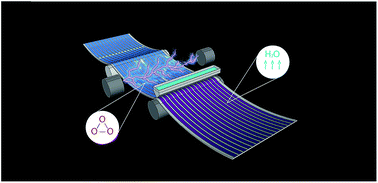The role of surface energy control in organic photovoltaics based on solar paints†
Abstract
The fabrication of organic photovoltaic devices from aqueous solar nanoparticle (ASNP) inks or solar paints is challenging, driven by the often competing requirements of maintaining emulsion stability whilst simultaneously facilitating surface wettability. In this paper, we have investigated multiple pathways for successfully coating ASNP inks across a range of fabrication scales. Initial attempts at roll-to-roll (R2R) printing of ASNP inks focussed simply on optimising film quality by altering the free-SDS concentration in the ASNP inks. Although high quality films were produced, the prepared R2R printed devices exhibited low performance, driven by the high SDS content of the printed films. Consequently, a detailed study of the effect of surface ozone treatments on ASNP film formation was undertaken. The work function, contact angle, surface composition and surface morphology were investigated as a function of surface ozone treatment for a range of PEDOT:PSS hole-transport layer (HTL) electrodes on small-scale devices. Optimised ozone surface treatments yielded nanoparticle organic photovoltaic (NP-OPV) device efficiencies of 1.5%, with the surface characterisation revealing that the ozone treatment of the HTL films predominantly results in increased PSS surface concentration. Transferring these results to R2R scale devices showed that surface ozone treatments can be used to successfully coat medium SDS content ASNP films of good quality resulting in large area devices with an efficiency of 0.45%; highlighting the role of surface energy control in determining device performance of R2R OPV devices fabricated from solar paints.



 Please wait while we load your content...
Please wait while we load your content...